Its firework season and our skies are filled with bright lights and sound. In fact, it’s the busiest time of year for the Fireworks Manufacturers Association of Sri Lanka – only the Sinhala and Tamil New Year will provide equivalent sales, says Association President Lawrence Fernando, adding that a post-war bump in demand has encouraged the 110 manufacturers who make up the membership of the Association. New markets in the North and East are now accessible and that has only contributed to the boom time.
 |
| It’s the season for fire crackers |
Mr. Fernando has a plant in Meegamuwa near Negombo – this place is dense with other firework factories and is often considered the heart of the trade in Sri Lanka. From the factories comes a steady stream of all the fireworks we love best – the Catherine wheels and the long strings of firecrackers, the rockets and sparklers, the skyrockets and the fountains and of course, the bombs. The most expensive on the menu are the shell rockets which cost Rs.4,000 a pop, but you can buy boxes of the humbler sort for Rs.600 upwards.
Sri Lanka has never had firework displays to rival that of other Southeast Asian countries like China and Singapore. Famous though is the firework display that welcomed Elizabeth II on her 1954 tour of the island and more recently at the turn of the Millennium the Association staged a firework display that cost the government three Lakhs. Though such displays are clearly few and far between, Mr. Fernando says the association regularly stages smaller events. Though they do their best, he’s matter of fact about how they’re unlikely to draw international acclaim. Part of the reason for this appears to be the state of our manufacturing processes.
Dubbing them prehistoric, Mr. Fernando points out that Sri Lankan factories typically work with only seven chemicals, whereas the more advanced manufacturers abroad can draw from a palette of up to 125 chemicals. Nandasena Kandauda, who has his own factory in Galle where he sells his products under the brand of ‘Popular Fireworks,’ concurs with Mr. Fernando. His is a family business, founded by his grandfather and he now runs it with his son. They produce a range of 18 fireworks, among which Mr. Kandauda counts items like his ‘Box of Serpents’ and ‘China Shot’.
Catering to hotel events, weddings and big parties, Mr. Kanduada says he tailors displays to his client’s budget. A five minute show could burn up Rs.10,000 but he reveals that the trick is in the pacing. Stringing out the fireworks might make the show last longer, however that doesn’t create quite the same impact. Mr. Kandauda tells me that he likes to watch professional displays on T.V and that he picks up tips from them and new ways of doing things. It’s bound to come in handy since he feels that more and more people seem to be keen on celebrating major festivals and events of personal significance with a firework display.
He’s 60 years old. Mr. Kandauda says the technology hasn’t changed much in his time and many of their components are still handmade. His staff aren’t equipped with degrees in chemistry, instead they rely on long experience and careful experimentation. If only they could be sent abroad for training, they could attempt more adventurous displays, he says. On his part, Mr. Fernando wishes that the government would take an interest. He believes that supporting the industry could be good for the country in the long run, perhaps providing a new source of foreign income and generating tax money through issuing licences and permits.
When asked about safety issues both men are indignant, arriving separately at the metaphor of driving. Who is behind the wheel of a car and how the driving is done determines safety, they say. In the hands of a drunk or reckless driver, a vehicle becomes a dangerous thing. Fireworks similarly must be handled intelligently, they emphasize. Mr. Fernando adds though that a real concern is when unlicensed attempts are made to produce fireworks at home. Eschewing the likes of potassium nitrate which is relatively thermally stable and has a long shelf life, they resort to the use of illegal chemicals that are extremely flammable.
Once the season is over, the fireworks you see lining roadside stalls will make their way out of the city and into the countryside, where they will be welcomed by farmers. Loud noises and bright flashes are good for scaring away foraging elephants, says Mr. Fernando, and sky rockets do the trick with hungry monkeys and birds. |


